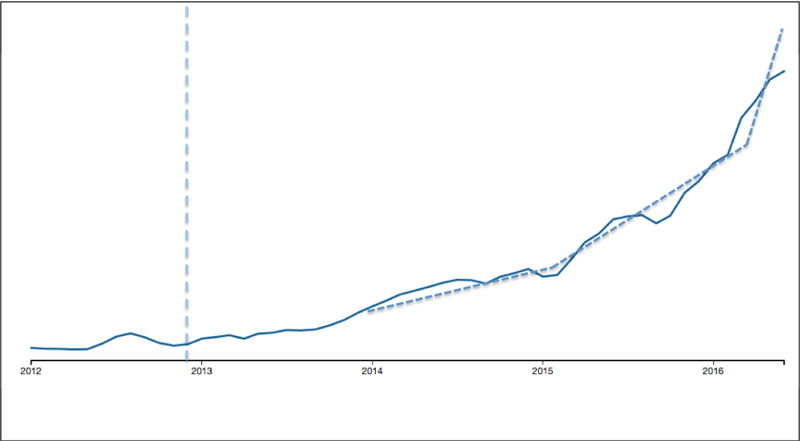A Brief History of AI
IV. The return of the Jed(AI)
Luckily enough, in 1993 this period ended with the MIT Cog project to build a humanoid robot, and with the Dynamic Analysis and Replanning Tool (DART) — that paid back the US government of the entire funding since 1950 — and when in 1997 DeepBlue defeated Kasparov at chess, it was clear that AI was back to the top.
In the last two decades, much has been done in academic research, but AI has been only recently recognized as a paradigm shift. There are of course a series of causes that might bring us to understand why we are investing so much into AI nowadays, but there is a specific event we think it is responsible for the last five-years trend.
If we look at the following figure, we notice that regardless all the developments achieved, AI was not widely recognized until the end of 2012. The figure has been indeed created using CBInsights Trends, which basically plots the trends for specific words or themes (in this case, Artificial Intelligence and Machine Learning).


More in details, I drew a line on a specific date I thought to be the real trigger of this new AI optimistic wave, i.e., Dec. 4th 2012. That Tuesday, a group of researchers presented at the Neural Information Processing Systems (NIPS) conference detailed information about their convolutional neural networks that granted them the first place in the ImageNet Classification competition few weeks before (Krizhevsky et al., 2012). Their work improved the classification algorithm from 72% to 85% and set the use of neural networks as fundamental for artificial intelligence.
In less than two years, advancements in the field brought classification in the ImageNet contest to reach an accuracy of 96%, slightly higher than the human one (about 95%).
The picture shows also three major growth trends in AI development (the broken dotted line), outlined by three major events:
i) The 3-years-old DeepMind being acquired by Google in Jan. 2014;
ii) The open letter of the Future of Life Institute signed by more than 8,000 people and the study on reinforcement learning released by Deepmind (Mnih et al., 2015) in Feb. 2015;
iii) The paper published in Nature on Jan. 2016 by DeepMind scientists on neural networks (Silver et al., 2016) followed by the impressive victory of AlphaGo over Lee Sedol in March 2016 (followed by a list of other impressive achievements — check out the article of Ed Newton-Rex).
